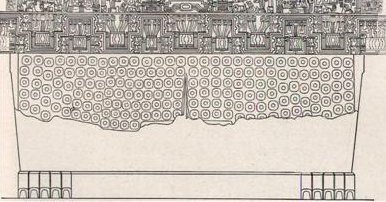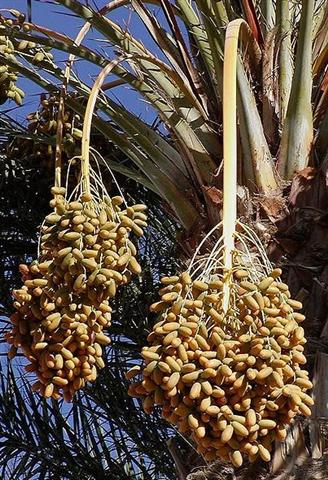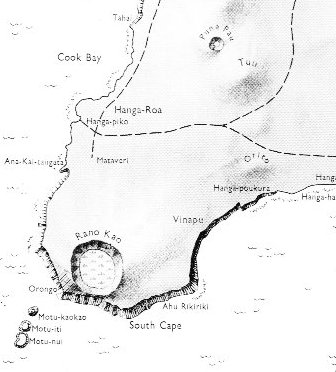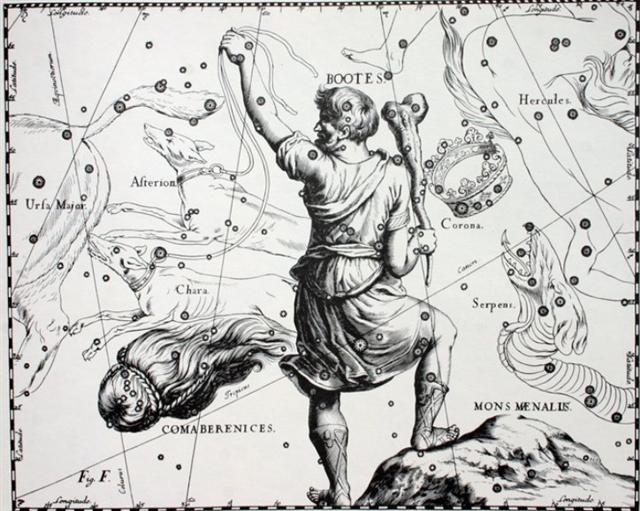According to Manuscript E the cycle of Makoi measured 60
places (E:38 - E:42). The geography of Easter Island was
circumnavigated clockwise and the end (Apina Nui) was
close to the beginning (Apina Iti), like alpha and omega.
Or like Furrow and Frond:
...
Frond (Coma Berenices & western part of Virgo).
The Frond is represented in the heavens by
the figure of the goddess Erua
... Number 2 is reiterated in several ways in the text on page
E:35. And below the midline of Pachamama (the World
Mother) the day circles are drawn double:

... he ea a Ira.he too mai i te moai maea.erua.erua
tuitui reipa.te ingoa o tau moai maea era.erua ko apina
iti.katahi. ko rapa kura.karua
...
... At the risk of invoking the criticism,
'Astronomers rush in where philologists fear to tread', I should
like to suggest that Taku-rua corresponds with the
two-headed Roman god Janus who, on the first of January, looks
back upon the old year with one head and forward to the new year
with the other, and who is god of the threshold of the home as
well as of the year... There is probably a play on words in
takurua - it has been said that Polynesian phrases usually
invoke a double meaning, a common and an esoteric one. Taku
means 'slow', the 'back' of anything, 'rim' and 'command'.
Rua is a 'pit', 'two' or 'double'. Hence takurua has
been translated 'double command', 'double rim', and 'rim of the
pit', by different authorities. Taku-pae is the Maori
word for 'threshold'... Several Tuamotuan and Society Islands
planet names begin with the word Takurua or Ta'urua
which Henry translated Great Festivity and which is the name for
the bright star Sirius in both New Zealand and Hawaii. The
planet names, therefore, represent the final stage in the
evolution of takurua which was probably first applied to
the winter solstice, then to Sirius which is the most
conspicious object in the evening sky of December and January,
and was then finally employed for the brilliant and conspicious
planets which outshone even the brightest star Sirius. From its
association with the ceremonies of the new year and the winter
solstice, takurua also aquired the meaning 'holiday' or
'festivity' ...
holding her sacred branch of the Date-palm.
Her constellation rises in the autumn months as the dates are
ripening on the fronds.

Furrow (Eastern half of
Virgo). The Furrow is obviously the origin of
our modern Virgo with her familiar ear of barley. The
constellation rises in the autumn when the fields have been
prepared and are ready to be sown with the coming season's
barley seed ...

|
he otea he ea a
Makoi.he oho he tuu ki a(-) |
It
grew light [on the 5th day] and Makoi got
up. He set out and came to Apina. When he
arrived there he gave the name |
| pina.he tuu
he nape i te ingoa. |
|
E:38 |
| 1
ko apina iti.ko rapa
kura.he oho mai |
'This is Apina Iti, this is Rapa Kura.'. He
went on and came to Hanga O Ua [Uo].
He gave the name 'This is Hanga O Ua [Uo]
of the beautiful wave (vave renga).'
Makoi went on, giving names, until he had
made a (complete) circle around both sides
(of the island).
In Apina Nui
a stone (maea) was erected [hakatuu],
saying that the naming was done on a (round)
trip during a single day. |
| 2 he
tuu ki hanga o uo.he
nape te ingoa.ko hanga o uo |
|
a vave renga. |
|
he nape he
oho a Makoi .i te ingoa.ka
vari ro |
|
a
arurua.aro i
apina nui i hakatuu ai |
|
te
maea.etahi no raa.i nape he oho ai. |
|
Vari.
1. Menstruation, period (also: tiko).
2. To tack, to veer (nautical);
ku-vari-mai-á te miro, the boat arrives,
have veered [around Rano Kau].
Vanaga. About, circumference, to turn in a
circle; hakavari, pliant, to bend,
square; varivari, about, to go
around; vavari, a garland;
varikapau, circumference, to surround, a
compass, to admire; hiriga varikapau,
to go in a ring; pa varikapau, to
close in; varitakataka (vari-taka
3) to surround. Churchill. Pau.: Vari,
marsh, mire, dirt. Ta.: vari, dirt,
mud. Rar.: vari, mud. Churchill.
Mgv.: Vari, paste well diluted. Mq.:
vaivai, to dilute, to thin. Ha.:
waliwali, soft, pasty. Churchill.
Áruáru, reduplication of aaru: to
grab firmly. Vanaga. 1. To pursue. P Mgv.:
aruaru, to run after, to chase, to
follow. Ta.: aruaru, to pursue. 2. To
raise in waves, undulation. P Pau.:
puhigaru, a bubble of water. Mgv.:
garu, foam, froth. Mq.: naú,
waves. Ta.: aru, billow, wave, flood.
3. (haruharu). Churchill. Haruharu.
To rob, to steal, to arrest, to seize, to
cling, to grasp unexpectedly, to take by
force; robber (aruaru, aaru).
Pau.: haru, to extort, to carry off,
to usurp. Ta.: haru, robber, to seize
by force. Churchill.
Aro. Face, front, side (of a
figure); ki te aro o ..., to the
front of ... Vanaga. Presence, body,
frontispiece; ki te aro, face to
face. P Pau.: aroga, the visage;
ki te aroga, opposite. Mgv.: aro,
presence, before; i te aro, in the
presence of. Mq.: aó, face, in the
presence of, before. Ta.: aro, face,
front, presence, view. It is probable that
more than one word is confounded in alo.
The significations which appear in Southeast
Polynesia are most likely derived from a
Tongafiti alo and do not appear in
Nuclear Polynesia. The alo belly and
alo chief which do occur in Nuclear
Polynesia are also probably Tongafiti, for
in Samoa and Tonga they are honorific and
applied only to folk of rank, a good
indication of borrowing by the Proto-Samoans
from Tongafiti masters. Churchill. In the
Hawaiian group, the western portion or side
of an island was called 'the front', ke
alo, of the land, and the eastern side
was called 'the back', ke kua. The
reason of such designations must be sought
in the fact of the arrival of the
inhabitants from the west. Fornander.
... Ira got up,
climbed up [he ea], went on, and
reached Ruhi Hepii. He drilled a hole into
the stone. After the hole was deep enough,
he took the ornament (rei) and put it
into the hole so that the shiny side (rapa)
was turned outward. [He gave the name Ruhi
Hepii.]
He turned around, climbed down [he turu],
went on, and entered the cave of Pu
Pakakina.
When he arrived there he sat down.
The young kinsmen
arrived and rested. It grew light. On the
second day, Ira said again, 'Go back to
riding the waves!'. They all went back out
there.
Ira got up [he ea a Ira] and again
picked up the (second) ornament. He took it
[he mau], went on, and came to
Apina Nui,
drilled a hole into the stone, put the
ornament in the hole, with the shiny side [te
rapa] to the outside, and gave (the
place) the name 'Pu' ... (E34) |
| 3
hanga roa a tuki
tukau 4
Okahu a
uka ui hetuu. |
MY OWN
IDEAS: |
| Hanga Roa (the
Great Bay) for making landfall (tuki)
in order to multiply (ku-kau)
together with
Okahu (oka-hu), the maiden
star-watcher (uka ui hetuu). |
|
Tutu.
1. Circle of fishing nets arranged in
the shape of a funnels or baskets. 2. To
light a fire; he-tutu i te ahi: to
burn something. 3. To hit, to strike, to
beat. Tûtú, to shake (something)
clean of dust or dirt; he-tûtú te oone o
te nua, to shake the dirt off a nua
cape. Tutuhi, to reject the
responsibility for a mistake onto one
another, to blame one another for a mistake
(see tuhi). Tutuki, to
stumble, to trip. O tutuki te va'e,
in order not to trip. Tutuma,
firebrand, partly burnt stick. Tuturi,
to kneel. Vanaga. 1. To beat bark for cloth.
PS Pau., Mgv., Mq., Ta.: tutu, id.
Sa., To., Fu.: tutu, id. 2. A broom,
to sweep, to clean. Mq.: tutu, to
beat out the dust. 3. To shake, to winnow.
Mgv.: tutu, to tremble, to leap. Mq.:
tutu, to shake. 4. To kindle, to
light, to ignite, to set fire, to burn. Mq.:
tutu, to burn, to set fire. 5. To
stand; hakatutu, to set joists. P
Mgv., Mq.: tutu, to stand upright.
Ta.: tu, id. Tutua (tutu
1): board on which bark is beaten into
cloth. PS Mgv.: tutua, a cloth
beater. Mq., Ta.: tutua, wood on
which cloth is beaten. Sa., Fu.: tutua,
id. Tutui: tutui ohio, chain,
tutui kura, shawl. Mq.: tuitui
kioé, chain. Tutuki: shock,
contusion, to run against, to collide;
tukukia, to run foul of. P Pau.:
tukituki, to strike, to pound, to grind.
Mgv.: tukia, to strike against,
shock, concussion. Mq.: tutuki, id.
Ta.: tui, id. Tutuma: 1. (tutu
- ma) a live coal. 2. Tree trunk T (?
tumu). Tutumata, ligament of
the eye, orbit, eyelid. T (tutumate,
eyelid G). Tutuu, bristling.
Churchill. Kau.1. To move one's
feet (walking or swimming); ana oho koe,
ana kau i te va'e, ka rava a me'e mo kai,
if you go and move your feet, you'll get
something to eat; kakau (or also
kaukau), move yourself swimming. 2. To
spread (of plants): ku-kau-áte kumara,
the sweet potatoes have spread, have
grown a lot. 3. To swarm, to mill around (of
people): ku-kau-á te gagata i mu'a i tou
hare, there's a crowd of people milling
about in front of your house. 4. To flood
(of water after the rain): ku-kau-á te
vai haho, the water has flooded out (of
a container such as a taheta). 5. To
increase, to multiply: ku-kau-á te moa,
the chickens have multiplied. 6. Wide,
large: Rano Kau, 'Wide Crater' (name
of the volcano in the southwest corner of
the island). 7. Expression of admiration:
kau-ké-ké! how big! hare kau-kéké!
what a big house! tagata hakari
kau-kéké! what a stout man! Vanaga. To
bathe, to swim; hakakau, to make to
swim. P Pau., Mgv., Mq.: kau, to
swim. Ta.: áu, id. Kauhaga,
swimming. Churchill.
Kaukau. 1. Horizontal poles of a
frame (of a hare paega, or a paina
statue): he-hakatu'u te tama o te
paina, he-kaukau, they erect the
vertical poles of the paina then they
lay upon them the horizontal ones. 2. Group
of people: e-tahi tuitui reipá i Te Pei,
ekó rava'a e-varu kaukau; i-garo ai i
Hiva, i te kaiga, a necklace of
mother-of-pearl is on te Pei, few
will find it (lit: eight groups of people);
it has remained in Hiva, in our
homeland. 3. To go through, to pass through
in unison; he-hogi-mai te ûka i te e'eo o
te pua kaukau-á i roto ite hare, the
girl smelt the fragrance of the pua
wafting inside the house. 4. Newborn baby's
first hand and feet movements (kaukau
or kau). The five stages of a
baby's development are: kaukau, puepe,
tahuri, totoro, mahaga. Puepue =
said of a newborn baby when, a few weeks
old, it begins to distinguish people and
objects: ku-puepue-á te poki.
Tahuri = of a new-born baby, to move
from side to side: ku-tahuri-á te poki.
Totoro = to crawl; ki totoro te
poki, when the baby crawls. Mahaga
= baby when able to stand by itself. Vanaga.
Oka.
1. Lever, pole; to dig holes in
the ground with a sharpened stick, as was
done in ancient times to plant vegetables;
used generally in the meaning of making
plantations. 2. The four sideways poles
supporting a hare paega. Okaoka,
to jab, to pierce, to prick repeatedly.
Vanaga. Digging stick, stake, joist; to
prick, to pierce, to stick a thing into, to
drive into, to slaughter, to assassinate;
kona oka kai, plantation; pahu oka,
a drawer. Okaoka, a fork, to prick,
to dig. Okahia, to prick. Churchill.
Hu. 1. Breaking of wind. T Mgv.,
uu, to break wind. Mq., Ta.: hu,
id. 2. Whistling of the wind, to blow,
tempest, high wind. P Pau.: huga, a
hurricane. Churchill. Mgv.: hu, to
burst, to crackle, to snap. Ha.: hu,
a noise. Churchill.
Uka hoa,
female friend, companion.
Ukauka:
1. Firewood. 2. Leathery, tough. PS Mgv.:
ukauka,
hard to chew. Mq.:
ukakoki,
leathery. Ta.:
uaua, id. Sa.:
u'a,
tough, tenacious, glutinous. To.:
uka,
sticky. Niuē;
uka, tough. Viti: kaukamea,
metal. Churchill.

|
Diadem (α Corona
Berenices) was evidently close to the Full Moon 4
days before Spica:
| Hetu erua |
tagata rere ki te ragi |
|
Hetu 1. To (make) sound; figuratively:
famous, renowned. 2. To crumble into embers (of a bonfire). Hetu'u. Star, planet; hetu'u popohaga
morning star; hetu'u ahiahi evening star; hetu'u viri meteorite. Vanaga Hetu 1. Star (heetuu); hetu rere, meteor; hetu pupura, planet. P Pau.: hetu, star. Mgv.: etu, id. Mq.: fetu, hetu, id. Ta.: fetu, fetia, id. The alternative form fetia in Tahiti, now the only one in common use, need not be regarded as an anomaly in mutation. It seems to derive from Paumotu fetika, a planet. Its introduction into Tahiti is due to the fashion of accepting Paumotu vocables which arose when the house of Pomare came into power. 2. Capital letter (? he tu). 3. To amuse. 4. To stamp the feet. Hetuhetu, to calk, to strike the water. Hetuke, sea urchin. Churchill. |
 |
 |
 |
| Cb8-1 (172 → solstice) |
Cb8-2 (565 = 392 + 173) |
Cb8-3 |
| CLOSE TO THE FULL MOON: |
| APAMI-ATSA (Child of Waters) = θ Virginis, ψ Hydrae (198.5), DIADEM = α Com. Ber. (198.9) |
AL DAFĪRAH (Tuft) = β Com. Ber. (199.4)
*158.0 = *199.4 - *41.4 |
σ Virginis (200.4)
*159.0 = *200.4 - *41.4 |
|
... Apami-Atsa ('Child of Waters', θ Virginis) at 13h maybe should be contrasted with Apam Napat ('Grandson of Waters') ... θ is on the front of the garment, below the girdle ... Moderns have no name for it, but in the Surya Siddhanta it was Apami-Atsa, the Child of the Waters ... Apam Napat is an eminent figure of the Indo-Iranian pantheon. In Hinduism, Apām Napāt is the god of fresh water, such as in rivers and lakes. In Zoroastrianism, Apąm Napāt is also a divinity of water ... Apām Napāt in Sanskrit and Apąm Napāt in Avestan mean 'grandson of waters' ... Sanskrit and Avestan napāt ('grandson') are cognate to Latin nepōs and English nephew, but the name Apām Napāt has also been compared to Etruscan Nethuns and Celtic Nechtan and Roman Neptune. In Yasht 19 of the Avesta Apąm Napāt appears as the Creator of mankind. Here, there is an evident link between the glory of sovereignty (Khvarenah) and Apąm Napāt who protects Khvarenah as the royal glory of Iranian kings. Apām Napāt is sometimes, for example in Rigveda book 2 hymn 35 verse 3, described as a fire-god who originates in water ... The reference to fire may have originally referred to flames from natural gas or oil seepages surfacing through water, as in a fire temple at Surakhany near Baku in Azerbaijan ... There is a conjecture that the word 'naphtha' came (via Greek, where it meant any sort of petroleum) from the name 'Apampat' ...

|
| Oct 5 |
6 |
7 (280) |
| 'Sept 8 |
9 |
10 (253 = 280 - 27) |
| "Aug 25 (237 = 8 * 29½ + 1) |
Hora iti 26 |
27 |
| (PAPA O PEA) |
AHU AKAPU |
|
Here above I have moved Ahu Akapu 1 day ahead, compared to my earlier presentations, in order to make it begin when the Full Moon reached Cb8-3 (→ 24).
Aka. 1. Anchor: he-hoa te aka, to drop anchor. 2. Root of certain plants (banana tree, taro, sugar-cane). 3. To be paralyzed by surprise. Vanaga. 1. Root; aka totoro, to take root. P Pau., Mq.: aka, root. Ta.: aa, id. 2. (āka) anchor. 3. Causative (haka). Churchill.
The Explorers stayed for 2 days in Ahu Akapu and Cb8-6 (→ 48) should therefore correspond to "September 29 when the Full Moon reached Spica. |
| CLOSE TO THE SUN: |
| April 5 (365 + 95 = 460) |
6 (96 = 80 + 16) |
7 |
|
1h (15.2)
β Phoenicis (15.1), υ Phoenicis, ι Tucanae (15.6), η Ceti, ζ Phoenicis (15.7) |
Al Batn Al Hūt-26 (Belly of the Fish) / Revati-28 (Prosperous) / 1-iku (Field Measure)
MIRACH (Girdle) = β Andromedae, KEUN MAN MUN (Camp's South Gate) = φ Andromedae (16.0), ANUNITUM = τ Piscium (16.5), REVATI (Abundant) = ζ Piscium (16.9)
REGULUS (α Leonis) |
ν Phoenicis (17.4), κ Tucanae (17.6)
*342.0 = *383.4 - *41.4
= *159.0 + *183.0 |
| 'March 9 (68) |
10 |
11 |
| "Febr 23 |
24 |
25 |
|
... The leap day was introduced as part of the Julian reform. The day following the Terminalia (February 23) was doubled, forming the 'bis sextum - literally 'double sixth', since February 24 was 'the sixth day before the Kalends of March' using Roman inclusive counting (March 1 was the 'first day'). Although exceptions exist, the first day of the bis sextum (February 24) was usually regarded as the intercalated or 'bissextile' day since the third century. February 29 came to be regarded as the leap day when the Roman system of numbering days was replaced by sequential numbering in the late Middle Ages ... |
| te hokohuki |
te moko |
vero hia |
tagata honui |
e ha mata |
|
Ha. 1. Four. 2. To breathe. Hakaha'a, to
flay, to skin. Vanaga. 1. Four. P Mgv., Mq., Ta.: ha, id. 2. To yawn, to gape. 3. To heat. 4. Hakaha, to skin, to flay; unahi hakaha, to scale fish. Mgv.: akaha, to take to pieces, to take off the bark or skin, to strip the leaves off sugarcane. 5. Mgv: ha, sacred, prohibited. Mq.: a, a sacred spot. Sa.: sa, id. Churchill. |
 |
 |
 |
 |
 |
| Cb8-4 |
Cb8-5 (172 + 4) |
Cb8-6 (177 = 6 * 29½) |
Cb8-7 (392 + 178 = 570) |
Cb8-8 (1½ * 314 + 100) |
| CLOSE TO THE FULL MOON: |
| γ Hydrae (201.0), ι Centauri (201.4) |
Al Simāk-12 (Lofty) / Chitra-14 (Bright One) / Horn-1 (Crocodile) / Sa-Sha-Shirū-20 (Virgin's Girdle) / ANA-ROTO-3 (Middle pillar)
MIZAR = ζ Ursae Majoris (202.4), SPICA = α Virginis, ALCOR = 80 Ursae Majoris (202.7)
SADALMELIK (α Aquarii)
*161.0 = *202.4 - *41.4 |
71 VIRGINIS (203.6) |
no star listed (204) |
HEZE = ζ Virginis (205.0), Southern Pinwheel Galaxy = M83 Hydrae (205.7) |
|
... Proclus informs us that the fox star nibbles continuously at the thong of the yoke which holds together heaven and earth; German folklore adds that when the fox succeeds, the world will come to its end. This fox star is no other than Alcor, the small star g near zeta Ursae Majoris (in India Arundati, the common wife of the Seven Rishis, alpha-eta Ursae ... |
| Oct 8 (240 + 41) |
9 |
10 |
11 (364 - 80) |
12 (285) |
| 'Sept 11 (354 - 100) |
12 |
13 (256 = 4 * 64) |
14 |
15 |
| "Aug 28 (240) |
Hora iti 29 |
30 (242 = 2 * 11 * 11) |
31 |
"Sept 1 |
| AHU AKAPU |
PU PAKAKINA A IRA |
| CLOSE TO THE SUN: |
| April 8 |
9 |
10 (100) |
11 |
12 |
| no star listed (18) |
ADHIL (Garment's Train) = ξ Andromedae (19.3), θ Ceti (19.7) |
KSORA (Knee) = δ Cassiopeiae (20.1), ω Andromedae (20.6), γ Phoenicis (20.8) |
δ Phoenicis (21.5) |
υ Andromedae (22.9) |
| 'March 12 |
13 |
14 (73) |
15 |
16 |
| "Febr 26 |
27 |
28 (59) |
29 |
"March 1 |

|










